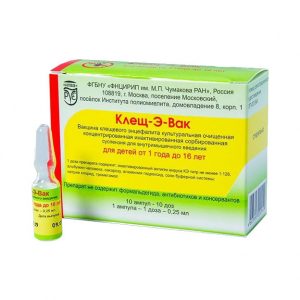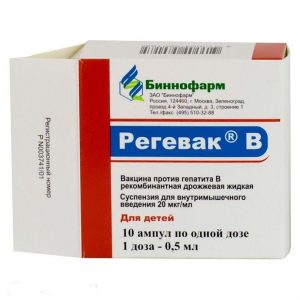Description
Latin name
RotaTec
Packing
10 tubes of 2 ml
Pharmacological action of
Pharamodynamics
Rotavirus (RV) is a cause of severe acute gastrogastroenteritis in infants and young children, affecting more than 95% of children by the time they reach 5 years of age, regardless of their socioeconomic status and environmental condition. According to estimates, every year in the world 138 million children get rotavirus gastroenteritis (RVH). In hot climates (tropical and subtropical), rotavirus gastroenteritis is a seasonal disease with epidemics occurring in the winter months. In the world, rotavirus causes about 28 to 71% of hospitalizations for diarrhea, regardless of geographic region and season.
Immunogenicity
Protection against natural rotavirus infection (RVI) is largely serotype-specific. The Rotatec ® vaccine contains the most common serotypes of human rotavirus G1, G2, G3, G4 and P1, which accounted for over 88% of all cases of RVI from 1973 to 2003 worldwide. The exact immunological mechanism by which Rotatec protects otrotavirus gastroenteritis is unknown. Studies indicate a combination of factors important for immunity against rotavirus, including neutralizing antibodies to external capsid G proteins, serum and secretory IgA, and other local mucosal responses. Rotatec ® induces antibodies that neutralize the serotypes G1, G2, G3, G4 and P1. In Phase III studies from 92. 9% to 100% of those who received Rotatec in a three-dose regimen achieved a significant increase in serum anti-tavirus IgA.
Efficacy
Rotatec ® provides protection against G-serotypes that are included and not included in the vaccine. In REST clinical trials, the efficacy against gastroenteritis of any severity caused by natural rotavirus among the G-serotypes included in the vaccine was 73.8%, and the efficacy against severe rotavirus gastroenteritis was 98.2% during the first rotavirus season after completion of vaccination. The efficacy against gastroenteritis of any severity caused by the non-vaccine serotype G9 was 74.1%. The effectiveness of Rotateka ®, during two rotavirus seasons after vaccination against rotavirus gastroenteritis, of any severity was 71.3%. Rotatek ® reduced the frequency of hospitalizations, emergency room visits, and the loss of working days for child care.
Efficacy and Safety in Premature Babies
In a placebo-controlled study of 1,007 premature babies (gestational age 25 to 36 weeks) who received Rotatek ® according to their chronological age, the Rotateka ® safety profile and efficacy (70.3%) were generally the same as safety and efficacy in the general population. studies with other vaccines children. Rotatec ® practically did not affect the minimal responses to these vaccines. In addition, studies have shown the effectiveness of Rotatek ® (89.5%) when given with these vaccines.
The safety profile, including the incidence of fever, vomiting, and irritability, was generally the same for all subjects who received the indicated concomitant vaccines with Rotatek ® and those receiving the indicated concomitant placebo vaccines.
Indications
Active immunization of children aged 6 to 32 weeks to prevent gastroenteritis caused by rotaviruses of serotypes G1, G2, G3, G4 and serotypes G containing P1A [8] (for example, G9).
Contraindications
a history of intestinal invagination
congenital malformations of the gastrointestinal tract, predisposing to intestinal invagination
immunodeficiency, suspected immunodeficiency or HIV carriage
acute in these cases, acute cases of inflammatory or inflammatory remission). An infectious disease of mild severity should not cause refusal to vaccinate
acute diarrhea or vomiting (in these cases the vaccination is carried out at the remission stage)
fructose intolerance, malabsorption of glucose-galactose complex, insufficiency of sucrose enzymes and (or)
isomaltase increased sensitivity to any component of the RotTek vaccine, as well as the introduction of the RotTek vaccine in history.
Caution
for active gastrointestinal diseases, including chronic diarrhea (lack of clinical data)
for delayed development (lack of clinical data)
for immunocompromised conditions (for example, as a result of malignant neoplasms or immunosuppressive therapy)
for transfusion of blood or blood products, including immunoglobulins less than 42 days before the intended vaccination.
Use during pregnancy and lactation
The RotaTek vaccine is intended only for children, there is no data on pregnancy and / or during breast-feeding.
Composition
1 dose (2 ml)
live reassortants human of bovine rotavirus? reassortant G1ne less than 2.2 106 IU *
reassortant G2ne less than 2.8 106 IU *
reassortant G3ne less than 2????. 2 Ã 106 IE *
? Reassortant G4 not less than 2 Ã 106 IE *
? Reassortant P1A [8] not less than 2.3 Ã 106 IE *
* IE – infectious unit
Excipients: sucrose – 1080 mg, sodium hydroxide – 2.75 mg, sodium citrate dihydrate – 127 mg, sodium dihydrogen phosphate dihydrate – 29.8 mg, polysorbate 80 – from 0.17 to 0.86 mg, culture medium – 15% (in volume ratio).
Dosage and administration of the
RotaTek vaccine is taken orally. Not intended for injection.
Vaccination Scheme
The vaccination course consists of three doses of RotaTek with an interval between doses of 4 to 10 weeks.
The first dose of RotaTek is administered to children aged 6 to 12 weeks.
All three doses are recommended before the child is 32 weeks old.
When introducing an incomplete dose (for example, a child spits out or burps part of the dose), it is not recommended to introduce an additional dose, since this dosage regimen has not been studied in clinical studies. The remaining doses should be administered according to the vaccination schedule.
RotaTek vaccine can be used in premature babies born with a gestational age of at least 25 weeks. The vaccine should be given to such children no earlier than 6 weeks after birth.
Vaccine administration rules
RotaTek vaccine is a ready-to-use liquid.
The vaccine can be used regardless of the meal or any liquid, including breast milk.
The vaccine must not be mixed with other solutions and vaccines in the same container. The vaccine must not be diluted or diluted. Do not use if external damage to the tube is found and / or the contents of the tube look unusual.
Guidelines for preparing and administering the
vaccination Remove one package from the refrigerator, tear it open and remove the plastic tube. If the vaccine tube is not placed in a foil package, then you should start from the second stage.
While holding the tube vertically with the cap up, tap the cap to remove fluid from the dispensing tip.
Pierce the dosing tip by turning the screw cap fully clockwise.
Turn the cap counterclockwise and remove it.
Inject a dose by gently squeezing the liquid into the baby’s mouth towards the inside of the cheek until the tube is empty (a drop of liquid may remain at the tip of the tube).
Side effects
Infectious and parasitic diseases: often – upper respiratory tract infections infrequently – nasopharyngitis, otitis media.
From the digestive system: very often – diarrhea, vomiting infrequently – pain in the upper abdomen, hematochesia * rarely – intestinal invagination *.- rash rarely – urticaria *.
From the respiratory system: rarely – bronchospasm.
General disorders: very often – hyperthermia.
Additional information
Kawasaki disease was observed in 5 out of 36150 children in the vaccine group (
The risk of intestinal invagination was assessed in a placebo-controlled study. When observed within 42 days after each dose, 6 cases of intestinal invagination were observed in the group receiving the Rototec vaccine (34 837 patients) and 5 cases in the placebo group (34 788 patients). There was no dependence of the development of intestinal invagination on the time after the administration of any dose.
Data from post-registration studies do not confirm increased risk of intestinal intussusception after vaccination with RotaTek.
Special patient groups
In children with severe combined immunodeficiency, cases of gastroenteritis caused by the rotavirus strains included in the vaccine have been reported. There is a risk of apnea in premature babies (those born during gestation up to 28 weeks inclusive).
Drug Interaction
RotaTec vaccine can be given at the same time to any of the following antigens, both monovalent and combination vaccines, toxoid hepatitis B virus vaccine, hexavalent vaccine (containing the above components), conjugated pneumococcal vaccine, serogroup C. meningococcal vaccine.
Oral administrationNo polio vaccine (OPV) and RotTec vaccine did not affect the immune response induced by OPV, but slightly decreased the immune response to RotTek, however, there is no evidence to support a decrease in the protection against severe forms of rotavirus gastroenteritis. The immune response to the RotTekne vaccine changed with the introduction of OPV two weeks after the administration of the RotTek vaccine.
Overdose
There are several cases of overdose with the RotTec vaccine. There are no differences in the profile of adverse events compared to the use of the drug at the recommended doses.
Storage conditions
In a dark place at a temperature of 2 8 ° C (do not freeze).
Expiration
2 Year
Active ingredient
Vaccine for the prevention of rotavirus and fektsyy, pentavalentnaya, live
Dosage form
dosage form
solution for oral administration
Merk Sharp and Doom B.V. , United States




